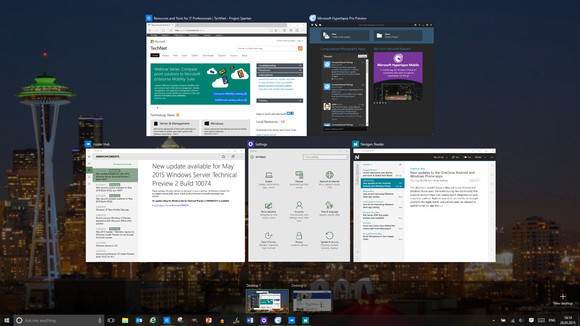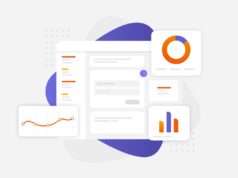None of us like wasting time when we’re trying to get stuff done. Every second spent shuffling around open windows or navigating menus is precious time not spent achieving your goals. Fortunately, Microsoft stuffed Windows with all sorts of secretly powerful tools, as we’ve covered in-depth in both 17 obscure Windows tools and tricks too powerful to overlook and 15 simple, secret Windows tips and tricks designed to save you time.
Fear not! All of those tips still work. But Microsoft managed to sneak even more productivity-enhancing goodies into every nook and cranny of Windows 10. Then the sweeping Anniversary Update added still even more. So let’s take a look.

The biggest productivity addition to Windows 10, in this humble geek’s opinion, is Task View. At a high level, Task View essentially mimes OS X’s Exposé feature, showing all your open windows at a glance. That’s useful enough, but there’s a particular sub-feature of Task View that’s even handier: virtual desktops.
Virtual desktops — long a Linux staple — allow you to create multiple virtual desktops for specialized micromanagement. For example, you could have one desktop devoted to research for a project, another for general work, and a third for more leisurely activities, switching between them as needed. Think of it as a poor man’s multi-monitor setup, but without all the extra hardware. Click the new Task View icon in the Windows 10 taskbar to get started, or read PCWorld’s Task View and virtual desktops tutorial for Jedi-level knowledge of this killer feature.

Task View also makes Windows’ Snap feature more useful. In Windows 8, Snap only allowed you to set Windows Store apps — not desktop apps — in a side-by-side vertical splitscreen view. In Windows 10, you can Snap desktop apps as well, and Microsoft added Quadrant Snap, which allows you to Snap open windows to the four quarters of your screen.
Once you’ve filled half of your screen with Snapped windows, Task View pops up in the “open” half, beckoning you to choose an app to fill the final portion with. Mmmmm, easy-peasy multitasking.

The first step to true productivity lies in the mastery of keyboard shortcuts. Many of the new Windows 10 features discussed here — especially Task View and Snap — have new associated keyboard shortcuts. Check them out!

This is a quickie but a goodie. As of the Anniversary Update, the taskbar calendar now integrates with Windows 10’s Calendar app, so summoning it reveals an overview of your tasks for the day in addition to the usual time/date view.

The Start menu makes its return in Windows 10 after being banished from Windows 8. But it’s not like the Start menus of Windows past; instead, it’s more of a mashup of the traditional Start menu with Windows 8’s live tile-infused Start screen. And believe it or not, it can actually help you process information faster.
Windows Store apps and most default Windows 10 apps can be configured to show updates and highlights right on your Start menu — an especially useful feature for the Calendar, Mail, and News apps. Live tiles are enabled by default, though you can toggle the functionality on and off by right-clicking on a tile in your Start menu and selecting More > Turn live tile on/off.
Even if you don’t appreciate the flashy live tiles, take the time to arrange your Start menu so that your most-used programs are front and center. That’ll save you precious navigation time if you don’t pin programs to your taskbar — it also helps keep your secondary software organized even if you do pin your most-used programs. Rearranging Start menu tiles is a simple drag-and-drop affair.

In general, the Cortana digital assistant’s search results are a lackluster, cluttered mess that focuses too heavily on apps and services over local files. Because of that, I pinned the superb Everything search tool to my taskbar and use that for general searches. But there’s one Cortana feature that I absolutely adore: Cortana’s smart search results, which surface relevant files based on natural language requests.
The other day, I needed to look up some receipts from the last CES. Typing “Find photos from January” in Cortana surfaced my clips in a jiffy. Looking for documents on a specific topic? Try something like “Find files about Radeon Fury.” It’s an extremely handy feature — and Cortana scans your OneDrive cloud storage in addition to your local drives when using smart search.

Cortana also packs a handy reminder function. If you need to remember to take an action at a certain time, just type something like, “Remind me to call Jennifer at six,” and Cortana will create a reminder for just that, which you’ll have to confirm. It’s quick, easy, and helpful — doubly so because the reminders become more powerful if you have the Cortana app installed on your phone.
If you do, you can ask Cortana to create reminders like, “Remind me to pick up milk when I’m at the store.” She’ll ask you to confirm which store, and the next time you’re in the area, you’ll receive a notification reminding you to buy milk. The future is a wonderful place, folks.

If you have the Cortana app on your Android or Windows Phone, the Windows 10 Anniversary Update adds the ability to see your mobile notifications right on your Windows 10 PC, and even respond to text messages. (The iOS Cortana app is much more feature-limited due to Apple policies.)
You’ll need the Cortana app on your phone first, of course. Once you’re logged in, open the settings and enable the various options under Sync Notifications. (The ability for your phone to send a low-battery warning to your PC can be a godsend, too.) Then, open Cortana’s settings on your Windows 10 PC and enable Send notifications between devices. Boom! Done. Now you’ll never have to pull your phone out of your pocket to see — and respond to — who’s blowing it up.

Hey, there’s one of those text message notifications in action!
Windows 10’s native pop-up system notifications are far handier than the Windows 8 iteration. Not only can you take direct action in many of them, but if you miss a pop-up, it gets stashed in Windows 10’s Action Center, which collects notifications and key information from all your installed apps. And after the Anniversary Update, a small bubble next to the Action Center’s icon shows you how many unread notifications are awaiting your attention. (Other Windows Store apps also display the number of unread notifications stashed in the taskbar.)
The system’s a handy way to surface and respond to timely information quickly, while allowing less critical tasks to wait for your attention. It’s especially useful if you head to Start > Settings > System > Notifications and actions and pare down the list of apps that can send you notifications to the true essentials.

While you’re in that Notifications and actions menu, take the time to peruse and configure the Quick Actions options as well. Quick Actions appear as buttons at the bottom of your Action Center; pressing them quickly activates (or deactivates) the specified task. They can prove pretty handy, especially if you travel frequently, connect to other devices or networks often, or lean heavily on OneNote.

Speaking of notes, if you have a touch-enabled PC or tablet, check out the new Windows Ink feature in the Anniversary Update. You can pull up a dedicated “ink workspace” (pictured) with tools and apps that support styli, and auto-create Cortana reminders based on written notes, for example.
Two of the three dedicated Windows Ink apps can help improve productivity. Sticky Notes, well, lets you quickly scribble down digital sticky notes, while Screen Sketch lets you grab a screenshot of your display, then quickly mark it up and share it online. They’re niche, but helpful — and Microsoft seems dedicated to amping up Windows 10’s inking capabilities even more in the future.



![[World Sleep Day] Recovering From Daylight Saving Time May](https://loginby.com/itnews/wp-content/uploads/2025/03/1741688395_World-Sleep-Day-Recovering-From-Daylight-Saving-Time-May-238x178.jpg)




